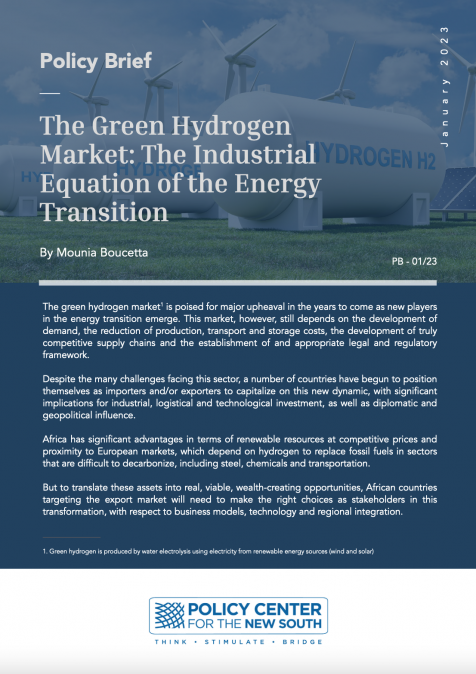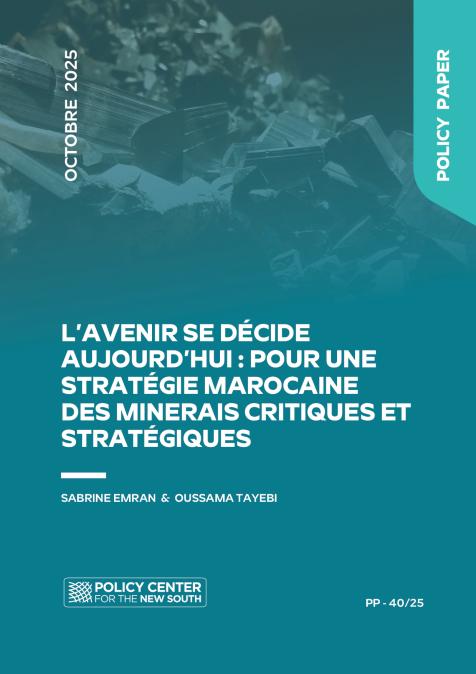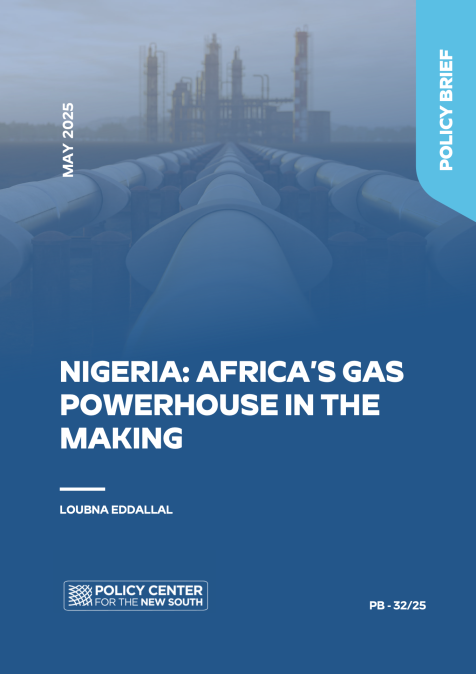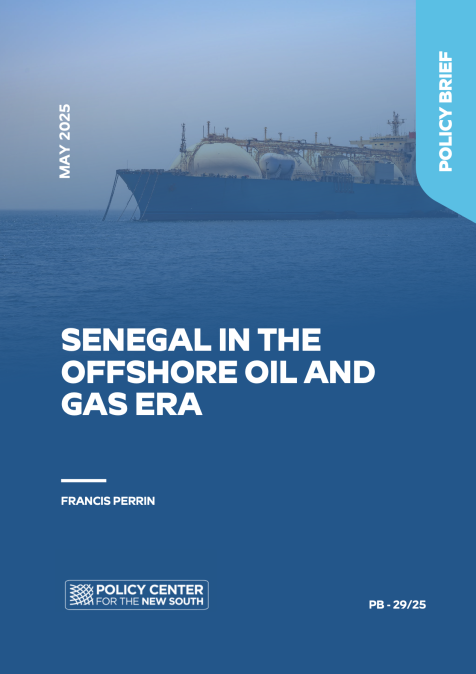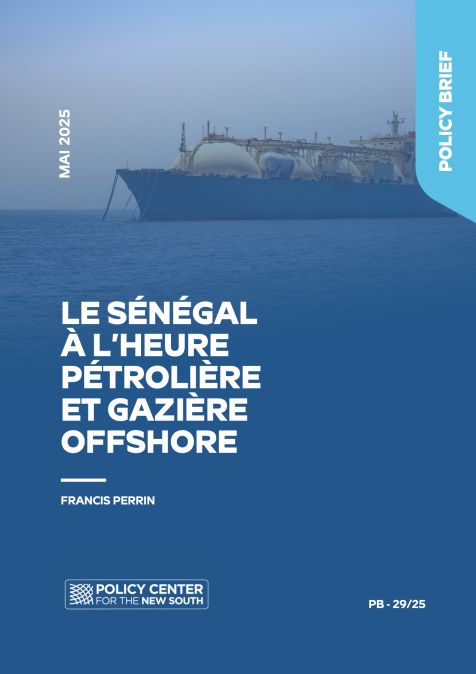Publications /
Policy Brief
The green hydrogen market1 is poised for major upheaval in the years to come as new players in the energy transition emerge. This market, however, still depends on the development of demand, the reduction of production, transport and storage costs, the development of truly competitive supply chains and the establishment of and appropriate legal and regulatory framework.
Despite the many challenges facing this sector, a number of countries have begun to position themselves as importers and/or exporters to capitalize on this new dynamic, with significant implications for industrial, logistical and technological investment, as well as diplomatic and geopolitical influence.
Africa has significant advantages in terms of renewable resources at competitive prices and proximity to European markets, which depend on hydrogen to replace fossil fuels in sectors that are difficult to decarbonize, including steel, chemicals and transportation.
But to translate these assets into real, viable, wealth-creating opportunities, African countries targeting the export market will need to make the right choices as stakeholders in this transformation, with respect to business models, technology and regional integration.
INTRODUCTION
The global landscape of the green hydrogen industry is being shaped by the emergence of multiple public and private players, driven by favorable conditions stemming from an energy crisis caused by the Ukraine-Russia conflict, on the one hand, and the commitments made by over 140 countries to cut carbon footprints on the other. Accelerating technological advances and closer strategic alliances among various global investors are also key factors in driving progress.
Morocco has also moved forward following the enlightened guidance of His Majesty King Mohammed VI at the November 22, 2022 meeting on the development of renewable energy and new opportunities in the sector. At this meeting, the Sovereign gave His High Instructions to develop, as soon as possible, an operational and incentive "Morocco Offer", covering the entire value chain of the green hydrogen sector in Morocco.
On December 3, 2022, Mr. Mostafa Terrab, Chairman and CEO of the Office Chérifien des Phosphates (OCP) Group, presented to His Majesty King Mohammed VI a major green investment project amounting to nearly $13 billion over the 2023 to 2027 period, which will ultimately supply green energy to all OCP’s industrial facilities. To this end, the OCP Group is planning major investments in seawater desalination (560 million m3) and production of 1 million tons of green ammonia. These investments will enable OCP to achieve carbon neutrality in 2040.
GREEN HYDROGEN MARKET TRENDS IN EUROPE
Driven by fast-paced technological developments and falling renewable electricity prices, green hydrogen is increasingly seen as the most promising green energy resource, despite the skepticism of some experts about its future.
Most hydrogen is currently produced from natural gas. This "gray or blue" hydrogen, albeit inexpensive, has the disadvantage of not meeting carbon neutrality objectives.
The viability of green hydrogen production currently depends heavily on developing demand and a global market, both of which are still relatively limited (hydrogen production amounted to 94 million tons in 2021, of which only 1 million tons was produced via low environmental impact technologies).
Widespread use of green hydrogen would foster the emergence of competitive value chains, and provide new investment opportunities for countries positioning themselves in this industry.
Green hydrogen holds great promise, as it can be stored and transported without a carbon footprint and has several promising applications, primarily in transport. Indeed, unlike electric engines, green hydrogen engines do not require recharging time.
The power sector is another high potential market, specifically for electricity production by gas turbines and fuel cells. Powering heavy industry, such as the cement sector, refineries and steel industries, is another very promising area for using green hydrogen, notably in derivatives , such as green ammonia.
The European Union, notably through the 2050 Low Carbon Strategy, published in 2018, and the Green Pact for Europe, presented in 2019, plans to decarbonize large parts of its energy consumption with renewable electricity and to use hydrogen as a renewable energy storage vector to bridge gaps in its needs. As such, the share of hydrogen in the energy mix could increase from 2% to as much as 14% by 2050, with hydrogen seen as having good potential to reduce and replace fossil fuels in hard-to-decarbonize sectors such as steel, chemicals and transport. More recently, as part of the REPowerEU Plan, launched in May 2022 to enhance energy security and address the effects of the Ukraine-Russia conflict, the European Union has set a target of 20 million tons of green hydrogen to replace natural gas, coal and oil by 2030 to power hard-to-decarbonize industries and the transport sector, where the EU is considering the deployment of 60,000 fuel cell trucks and a network of 1,500 hydrogen stations.
This 20 million tons of hydrogen would be supplied 50% from domestic production and 50% from imports.
On December 9, 2022, European Commission President Ursela von der Leyon said, "Hydrogen is a game changer for Europe...we want to maintain our European trailblazer's position, as we build a global market for hydrogen."
To this end, she announced the creation of a European Hydrogen Bank with a €3 billion budget. These funds are to support investment in the sector thereby ensuring competitive market prices.
A number of major investments have been announced in this respect, notably the hydrogen pipeline project linking Barcelona to Marseille by 2030. This project involves France, Spain and Portugal, with a €2.5 billion investment package to be submitted to the European Commission for funding. This pipeline is projected to transport around 2 million tons of hydrogen, i.e. 10% of European consumption.
Italy is also positioning itself as a future Mediterranean hub for green hydrogen, with the establishment of specialized zones around its main ports, the launch of major offshore wind projects and news of a gigafactory for the production of electrolysers.
Germany, a European pioneer in this sector, has launched several initiatives in partnership with other countries, notably through the "Power to X" alliance, and has funded studies for other projects.
Other initiatives include the setup of "hydrogen diplomacy" offices in Nigeria, Angola, Saudi Arabia as well as in Kazakhstan and Ukraine (currently underway), to foster hydrogen partnerships with these countries. Likewise, at the November 2022 COP27, Germany announced that it would mobilize €550 million to build a new global green hydrogen economy, potentially reaching €2.5 billion in the years to come.
In addition to environmental commitments, the European energy crisis has increased pressures on German manufacturers, to accelerate the transition to green energy as the only option for maintaining global competitiveness.
The German government accordingly announced a review of its 2020 green hydrogen roadmap. One of the goals is to accelerate the construction of production facilities with a total capacity of 10 GW by 2030 and to allow the use of blue hydrogen (produced from natural gas with captured carbon) during a transitory phase.
At the same time, integrated supply and demand "Hydrogen Valley" platforms that combine production and utilization infrastructures were recently launched in Europe to promote the development of green hydrogen at territorial level.
Around 20 projects are underway although not yet fully operational, with some focusing on mobility, others on a medium scale targeting the industrial sector, and others positioned as export platforms.
The Netherlands has initiated five hydrogen valley projects, notably near the port of Rotterdam and the Groningen gas region, making it the European leader in this area.
In recent developments, France and Germany, both with limited renewable potential, have been lobbying the European Commission for concessions on hydrogen production that is not strictly green, allowing for usage of non-renewable low-carbon energy sources (natural gas and nuclear). Their request is justified by the fact that meeting the 2030 zero-carbon targets will be very difficult, particularly for heavy industry.
For African countries, especially those in North Africa, Europe offers a very attractive potential market for green hydrogen, due to its geographical proximity and the proactive policy of the European Union in this area.
Indeed, the green hydrogen export market should remain primarily regional over the short and medium terms, on account of the weight of logistics costs stemming from limited supply chains, and largely impacted by market development and regulatory and incentive framework visibility.
Accordingly, a number of European investors are seeking to position themselves in the emerging green hydrogen market, looking for public or private partnership projects, to essentially target North Africa and the Middle East.
AFRICA'S POSITIONING IN THE GREEN HYDROGEN MARKET
A study released in December 2022 by the European Investment Bank, the International Solar Alliance and the African Union, found that Africa has the potential to position itself in global green hydrogen markets around four hubs: Morocco, Egypt, Mauritania and Southern Africa.
The continent could produce 50 million tons of green hydrogen by 2035, accounting for about 10% of the global market and requiring an estimated $680 billion to $1.3 trillion in investment by 2050, according to international studies. The incremental installation of such a production infrastructure depends, among other things, on input cost competitiveness, business climate and the attractiveness of the country for foreign investment.
Despite the continent's huge potential for low-cost green hydrogen production, reported investment announcements account only for 3% of projects under development worldwide. This rate, however, has grown significantly over the past three years. Accordingly, a number of megaprojects have been announced, though it is not entirely clear which are seriously committed and which are speculative. Recent assessments indicate that of the 20 or so projects announced, mainly targeting the green ammonia export market, 15% are currently undergoing feasibility studies and just 1% have secured investment approval. Technology choice and financial engineering are key issues for African countries at this stage.
Production projects would normally require suitable and competitive infrastructure for processing, transport and storage, to be developed by governments or through public- private partnership. However, very little information is available at this level.
Advances in electrolysis technologies and falling renewable energy costs could make Africa one of the most competitive global providers of green hydrogen, at a cost of USD 1.8-2.6 per kg in 2030, as opposed to the current level of USD 5-10 per kg. This cost is projected at US$1.2 to US$1.6 per kg by 2050 as technology performance and costs improve.
The same studies indicate that by 2050, Africa could export 20 to 40 million tons of green hydrogen per year and retain 10 to 20 million tons to meet the continent's domestic demand, providing clean and affordable energy to areas lacking energy resources and thus addressing the continent's low level of electrification, which stands at only 56% in 2021, and the decarbonization needs of the transportation and industrial sectors.
In this respect, African countries with relatively advanced positioning on green hydrogen export markets are: Morocco, Egypt, South Africa, Mauritania and Namibia.
African countries with gas resources, such as Nigeria and Angola, are more interested in blue hydrogen, produced from natural gas transformed into hydrogen and CO2, which is subsequently captured and stored.
South Africa has set a production target of 500,000 tons of green hydrogen by 2030 and harbors major export ambitions by 2050 (10% of the global green ammonia market). Its strategy also includes decarbonizing its heavy industry, with a medium-term focus on the transport sector. Projects are planned in specialized tax-advantaged zones in Johannesburg, Durban, Mogalakwena and Limpopo.
Despite the South African government's strong ambition, several criticisms have been made following the launch of its green hydrogen plan, because of poor electrification rates across parts of the country and a long overdue energy transition.
The German special envoy for the Just Energy Transition Partnership (JETP) with South Africa, Rainer Baake, is quoted by South Africa's Daily Maverick's December 9, 2022 edition as saying at COP27: “In a country where during this year 25% of the hours there was no electricity for the people of South Africa, I think it is a little bit ridiculous to use the electricity from wind and solar to produce hydrogen derivatives for the European market.” The government of Egypt has signed a number of MoUs providing for the construction of green hydrogen and ammonia production units around the Red Sea port of Ain Sokhna and the Suez Canal. Several announcements were made by different investors, ranging from 100 MW to 9GW in production capacity, currently under study. Egypt is taking an integrated approach that includes the Renewable Energy Authority, the Electricity Distribution Company, the Suez Canal Economic Zone Authority and the Egyptian Sovereign Wealth Fund.
In a related development, Egypt announced the launch of a study for the establishment of a grid dedicated to renewable energy projects alongside the current grid to transfer renewable energy capacity to the production of green hydrogen and derivatives.
In a competitive bidding process, Namibia reached an agreement with a selected operator for a 300,000 ton per year green hydrogen project with an investment of $9.4 billion. The first phase of the project will go live by 2026, in the Tsau Khaeb National Park with a capacity of 2GW. The government plans to retain a 24% stake and is exploring options for raising its financing. The German government has provided €40 million for the pre-feasibility phase. Namibia's strategy also includes a package of measures to improve the business climate, including the creation of proper governance, development of a regulatory framework to create an enabling environment and comply with international standards and requirements, and launching pilot projects to develop local industrial base capacity.
Mauritania is positioning itself for large-scale projects, particularly in the northern desert and the coastal regions of Dakhlet Nouadhibou and Inchiri, with targeted production capacities of 1.7 million tons of green hydrogen and 10 MT of green ammonia.
MOROCCO'S POSITIONING
Over the past two decades, Morocco has made strategic choices that have improved its industrial and logistical competitiveness and elevated it to world class ranking, particularly in the automotive, aeronautics and fertilizer sectors.
A recent report by the African Development Bank (AfDB) ranked Morocco second in Africa on industrial performance. This ranking is based on 19 indicators, including manufacturing performance, capital, labor, business environment, infrastructure and macroeconomic stability.
Morocco's proactive policy has led to major renewable energy projects in solar and wind power, positioning it as a world leader in this sector.
According to the latest Renewable Energy Country Attractiveness Index (RECAI) report, "Morocco has topped the adjusted index thanks to its ambitious plans for solar, wind and more recently green hydrogen, in pursuit of a 52% green energy share by 2030." Also, existing or planned interconnections with Europe, a green hydrogen roadmap established in 2021, the Green H2 cluster, desalination projects underway, and a number of partnerships, including with Germany, the Netherlands, and the EU, further cement Morocco's position as a reliable player in the green hydrogen market and in leading large-scale projects.
This emerging sector still holds many uncertainties for investors, who need knowledgeable and reliable partners and an attractive and stable business environment to mitigate risks and ensure a return on investment.
Considering the significant and swift market developments, the Royal Directives at the meeting of November 22, 2022 reaffirm Morocco's relevance in capitalizing on achievements, building an attractive and operational offer and promoting competitive value chain development.
Consolidation of investments made, or underway, particularly in renewable energy, logistics and industry, Morocco's geostrategic positioning, business environment, as one of the most attractive in the region, and research and development projects undertaken, including through the University Mohammed VI Polytechnic (UM6P), are all relevant factors in developing Morocco's offer.
It is noteworthy that competition in this sector will not only be regional or continental, as European countries (especially those around the Mediterranean), also plan to produce 50% of domestic needs with substantial industrialization and innovation objectives, targeting competitiveness throughout the production and transit value chain, and ensuring sovereignty and strategic autonomy. A number of Middle Eastern countries, on the other hand, have taken the lead thanks to oil trade surplus and global partnerships.
Admittedly, Morocco holds competitive advantages for the supply of green hydrogen and derivatives to Europe, however, developing this sector raises strategic issues including the development of local versus export markets, industrial viability through local integration, infrastructure development and optimization of logistics costs, proper institutional and regulatory frameworks, as well as the place of research and development (R&D) in support of technological developments.
Competitiveness should be in all process levels, industrial, logistics and technological. The industry - logistics - R&D triptych is now more than ever the foundation of emerging sectorsthat can ensure their viability and resilience. It is essential to include all national stakeholders in an integrated, dynamic and modular vision that encompasses, among others, potential clients, investors, SMEs/SMIs, clusters, production and logistics zone developers, start-ups, research and training centers, etc., to maximize local economic, social and environmental impacts.
CHALLENGES AND PROSPECTS....
Pursuing the global green hydrogen market will require significant investments, technological choices and careful planning to best manage risks. The growth of this market depends heavily on how the key stakeholders - financiers, technology developers and users - play their part.
This energy transition is not simply a matter of replacing one fuel for another, but rather a true system changes on a global scale that will certainly have political, economic and environmental implications.
Consequently, a number of studies emphasize the diplomatic issues, related to the economic diplomacy of green hydrogen trading countries, given its energy security and geopolitical implications. Some countries, like Germany and Japan, which will be importers of green hydrogen, are already engaged in this logic and have implemented a specific diplomacy. Exporting countries are also expected to position themselves as influential players in this transition.
The major challenges to deploying green hydrogen today, as identified by the International Renewable Energy Agency, are as follows:
-
The cost of green hydrogen is still relatively high compared to high carbon fuels, including costs of production, transportation, conversion and storage;
-
Certain technologies in the hydrogen value chain are still at a low level of technological maturity and require large-scale testing;
-
Energy efficiency is another major challenge. The production, transport, conversion and use of hydrogen incur significant energy losses at each step of the value chain;
-
The availability of sufficient renewable electricity is another risk. Indeed, by 2050, hydrogen production with electrolysers could consume up to 21,000 TWh, which is almost as much electricity as is produced in the world today;
-
Uncertainty about hydrogen-specific policy and regulation remains a concern for investors;
-
Standards and certifications are essential to support growth in the sector and enable the production of official statistics;
-
Finally, the demand increase is a key factor for lowering technology costs and for the deployment of large-scale investments. As with the renewable energy sector, the cost of producing green hydrogen is expected to fall as more electrolysis projects are built.
As far as Africa is concerned, in addition to the above-mentioned challenges, we must be aware that, even if there is strong investor interest in the continent, the development of electrolysis technology in the short and medium terms will determine the most viable investment programs and business models for African countries, in terms of debt exposure, return on investment, job creation and added value, emergence of national operators and acquisition of the technological mastery.
Moreover, the production of green hydrogen requires water, while not deemed excessive (about 10 l/1 kg H2), but that could impact the hydric situation of countries, calling for the adoption of adequate, viable and sustainable technological solutions that do not increase the vulnerability of these countries.
Finally, and alongside export development outside the continent, developing the domestic market and intercontinental trade are central elements for African countries to ensure they are not excluded from future value chains. Such development requires a proactive country strategy and an appropriate legal, regulatory and fiscal framework to lay a solid foundation for this development.
BIBLIOGRAPHIE
-
https://votoh.com/bilan-hydrogene-2022-la-demande-augmente-mais-seulement-1- est-renouvelable/
-
A Clean Planet for All. A European strategic long-term vision for a prosperous, modern, competitive and climate neutral economy, COM (2018) 773
-
https://ec.europa.eu/commission/presscorner/detail/fr/IP_22_3131
-
https://s3.production.france-hydrogene.org/uploads/sites/4/2022/02/France-
Hydrogene-Mobilite_Livre-blanc-Camion-H2_web-final.pdf
-
https://journalauto.com/industrie/vers-une-banque-europeenne-de-lhydrogene/
-
https://www.francebleu.fr/infos/environnement/le-pipeline-d-hydrogene-vert-entre- marseille-et-barcelone-sera-operationnel-en-2030-9895339
-
https://www.reuters.com/markets/europe/de-nora-sees-works-hydrogen-gigafactory- italy-start-h2-2023-2022-12-16/
-
https://www.h2diplo.de/en/
-
https://www.dw.com/en/germany-bets-on-global-green-hydrogen-
economy/a-63757016
-
https://www.cleanenergywire.org/news/german-hydrogen-strategy-revision-aims- solidify-target-double-electrolysis-capacity-2030-media
-
https://www.euractiv.fr/section/energie/news/des-projets-de-vallee-de-lhydrogene- voient-le-jour-en-europe/
-
https://www.sciencesetavenir.fr/nature-environnement/nucleaire/la-france-et-l- allemagne-veulent-assouplir-la-notion-d-hydrogene-vert_168465
-
https://www.dw.com/en/is-hydrogen-changing-the-power-dynamics-in-the-energy- world/a-64224508
-
https://www.eib.org/fr/press/all/2022-574-new-study-confirms-eur-1-trillion-africa-s- extraordinary-green-hydrogen-potential
-
https://www.howwemadeitinafrica.com/africa-could-capture-10-of-global-green- hydrogen-market/148795/
-
“Tracking SDG 7 : The Energy Progress Report” BAD
-
https://www.dailymaverick.co.za/article/2022-12-09-green-hydrogen-neocolonialism-
greenwashing-or-just-transition/
-
https://afrique.le360.ma/economie/legypte-lance-la-construction-de-sa-premiere- usine-de-production-dhydrogene-vert_DTJ2OJI7QNEJZBDPPRIOKUBP5I/
-
https://www-rechargenews-com/energy-transition/billionaire-forrest-launches-9gw- renewables-fuelled-hydrogen-megaproject-in-egypt/
-
https://climatechampions-unfccc-int/africa-green-hydrogen-alliance/
-
https://www.irena.org/Digital-Report/
-
https://www.marketsandmarkets.com/Market-Reports/green-hydrogen- market-92444177.html
-
https://www.azocleantech.com/article.aspx?ArticleID=1630
-
https://energycapitalpower.com/largest-upcoming-green-hydrogen-facilities-in-africa/
-
https://www.weforum.org/agenda/2022/11/hydrogen-clean-energy-transition
-
https://www.moroccoworldnews.com/2022/08/350851/morocco-hosts-19-3-of-all- blue-green-hydrogen-projects-in-mena

